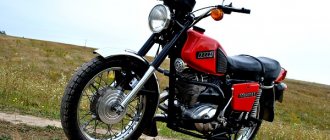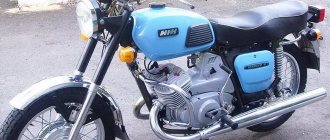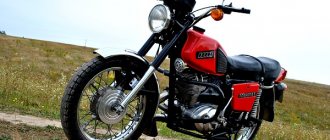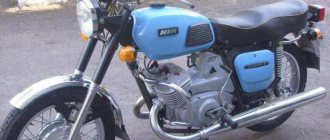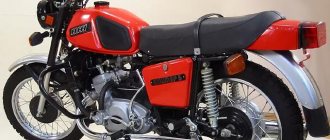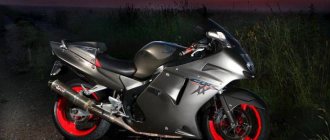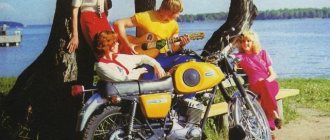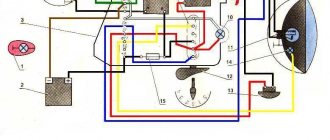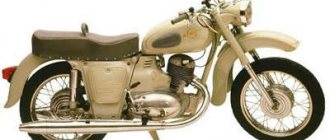Today you are unlikely to see old Soviet IZH motorcycles in big cities. This is not surprising, because the motorcycles of the Izhevsk plant have long since retired. However, you can still see on message boards numerous offers for the sale of the good old IZH Jupiter 3. It is this motorcycle that will be discussed in today’s article. We will discuss the technical characteristics of the motorcycle, talk about the advantages and find out where you can find old, but not completely dead equipment.
IZH Jupiter 3 - a classic that is remembered
“Troika” at one time became the motorcycle that everyone wanted. Naturally, until the release of Jupiter 5. The third Jupiter attracted a lot of attention thanks to the new engine, now it had two cylinders. This added a significant increase in power to the motorcycle compared to other Soviet motorcycles of the time. The very first motorcycle was made and introduced in 1971. By the way, this model was produced until 1981, i.e. for ten whole years. There was a logical explanation for this - the motorcycle was in great demand due to its two-cylinder engine and a number of other advantages, which we will discuss a little later. IZH Jupiter 3 was sold in only one color scheme. The tank on the motorcycle was painted white, while the frame, glove compartments, fenders and even the rims were painted blue. The only chrome surfaces left are the engine, exhaust pipes and shock absorbers.
Moreover, the motorcycle had two configurations - Jupiter 3 and Jupiter 3K. Both versions of the motorcycle are completely identical to each other, but the 3K version was sold together with a sidecar mounted to the right of the motorcycle. By the way, the stroller could be detached, but to do this you had to have wrenches with you. It is unknown why the manufacturer did not come up with an easier way to detach the stroller; perhaps bolting seemed more reliable.
Additional modifications
During production, the car was modified twice. From 1977 to 1980, Izh Jupiter 3 01 was produced, which had a number of differences from the basic version. The model received:
- Possibility of adjusting the gap between the mudguard and the wheel. This was important when operating on country roads.
- Anti-theft lock. In connection with this, the ignition switch circuit has changed.
- Safety bars.
- Standard rear view mirror.
- The rear shock absorbers are of a new design with three positions of stiffness adjustment.
- Changed design of mufflers.
- Rear brake locking, making it easier to install on the parking stop.
There were a number of other minor changes, but they mainly concerned the appearance. As for the performance characteristics, they remained at the same level. From 1979 to 1981, the Izh Jupiter 3 02 was produced, the main difference of which was the fuel tank of a new design and shape.
What is so good about IZH Jupiter 3?
In addition to the new, improved engine, the motorcycle had a number of other advantages that made it so popular. The first thing worth noting is its modern appearance. In 1971, this motorcycle could well be called modern and beautiful. There were two light bulbs installed on the dashboard, which was built into the headlight of the motorcycle. The red one informed about the presence of the ignition, which indicated that the engine could be started. The green light signaled that the motorcycle was at neutral speed, namely between first and second gears. Basically, the neutral speed signal on Jupiter 5 only worked between these two speeds.
The first buyers immediately noted the comfort of movement. Indeed, when developing the motorcycle, the IZh plant tried to make it more comfortable. To achieve this, softer rear shock absorbers were installed, and the front fork travel was increased. We also worked on the seat - now it has become inseparable and quite elastic. By the way, a rear fender was attached to the seat, on which a brake light, turning lights and a license plate bracket were located. By the way, Jupiter 3 was the first motorcycle from the Jupiter series to be equipped with turn signals.
The motorcycle sat in this barn for 38 years.
0
The stroller was stored upside down: so as not to take up much space
0
At one time, the state allocated this device to one forester in the Cherkasy region - to tour forestry areas. However, for these purposes he already had an older Izh Jupiter-2 in good condition, so the man decided to save the new equipment for better times and locked it in a dry barn for many years. They didn’t even register him with the traffic police!
0
The motorcycle remained in this barn until 2014, when the owner’s grandson finally decided to get Soviet equipment out of the rubble, which had already become a rarity in 38 years. And especially in this condition!
0
The mileage on the speedometer is 3 kilometers, and it is recorded in the accompanying documentation that came with the motorcycle. He also drove these kilometers around the factory testing ground: a test run to identify defects and assembly defects.
Motorcycle Specifications
In terms of technical characteristics, the IZH Jupiter 3 motorcycle is far ahead of its predecessors. Thanks to two cylinders, the total cubic capacity of this engine is 350 cm3. As a result, the power increased to 25 hp. For example, Jupiter 2 motorcycles had engines with a power of only 18 hp. Due to the increase in power, the motorcycle began to accelerate to 120 km/h without an attached sidecar, but the kickstarter was still used to start the engine.
At that time, water cooling was a real luxury, as a result of which the manufacturing plant did not dare to install “water cooling” on this model. That is why the engine received air cooling, which, with proper care of the motorcycle, was quite effective. However, it still couldn’t be done without stops to cool the power unit. When it got very hot on a hot day, the engine simply stopped “pulling,” which forced the owner to stop for a smoke break.
The gearbox, like any other gearbox on motorcycles of that time, was 4-speed. Over the entire existence of the model, it has proven its reliability. Even if the gearbox failed, the cause was usually improper operation. For example, not adding enough oil, starting too quickly, and so on. IZ Jupiter 3, in principle, is a fairly reliable model and even now, after so much time, it does not cause its owners much concern.
Due to the new two-cylinder engine, the installation of two exhaust pipes and other things, the motorcycle has gained weight. The dry weight of the motorcycle was 162 kg, excluding the side trailer. With a full tank of 18 liters, filled with oil and the sidecar installed, the motorcycle weighed all of 240 kg.
Photo gallery
IZH Jupiter 3 is a Soviet road motorcycle, middle class. The designers did a great job creating it, and as a result they got a comfortable, reliable and easy-to-use motorcycle. And you can evaluate his external data in our small selection.
Where to find and buy Jupiter 3?
The IZH Jupiter 3 motorcycle is one of the first motorcycles to receive a two-cylinder engine. At one time, he became a kind of personification of power, comfort and beauty. The unique design, the presence of a side trailer and other factors make this motorcycle very recognizable and special among restorers of old equipment. Unfortunately, finding a working and well-preserved Jupiter 3 is almost impossible in our time. As a rule, repairs and restoration are indispensable. In addition, after 30 years it is quite difficult to find a motorcycle with documents.
But if you have a burning desire to become the owner of the good old “troika”, then you can try looking for advertisements for sale on the Internet. Most motorcycles are located outside the countryside, in some villages and hamlets. As a rule, motorcycles are in some grandfather's garage. If you are a true motorcycle enthusiast and can purchase and qualitatively restore a Jupiter 3, you will receive an almost collectible bike with a great history.
Main disadvantages
All modifications were marked with a quality mark and were generally reliable. Owners of equipment made at the Izhevsk Machine-Building Plant were given headaches by:
- A weak generator, the power of which was not enough to power all electrical appliances at night.
- An ignition system made according to a separate circuit for each cylinder. In general, it is quite reliable, but setting the ignition evenly on the Izh Jupiter 3 is not an easy task.
- The electrical wiring is not of entirely satisfactory quality. Owners of new cars often complained that the wires were mixed up at the factory.
Nevertheless, the popularity of the model was great, and if anything stopped potential buyers, it was the fairly high price. Over the course of a year, the plant produced over 250,000 cars that went on public sale. The successful design became the basis for the creation of the following modifications, the latest of which was Izh Jupiter-5.
Motorcycle design
But structurally the motorcycles of these modifications did not differ from each other. All components of the motorcycle were mounted on a tubular frame. To provide suspension for the rear wheel, there was a subframe at the rear of the frame, attached to the frame by a non-rigid bolt connection.
A power unit with a gearbox and a steering column equipped with a telescopic fork were installed on the front part of the frame. The fuel tank was located above the engine, and in front of it was the steering wheel, dashboard and headlight.
Behind the tank, the entire upper part of the motorcycle was allocated under the seat, with a rear fender with a brake light attached to it. Below the seat there were two glove compartments. The left one was for the battery, and the right one was for tools.
The rear wheel was installed on the existing subframe. To provide its suspension, the subframe, in addition to the non-rigid bolted fastening, was connected to the frame by means of spring-loaded oil shock absorbers. The springs had three-position adjustment, which provided a change in the rigidity of the rear suspension. The rear wheel was driven by a chain drive.
Exhaust pipes extending from the engine stretched along the entire motorcycle. To protect the driver and passenger from possible burns, the pipes were attached under the running boards.
The motorcycle was equipped with two-cam drum brakes with mechanical drive on both wheels. Subsequently, some versions were equipped with hydraulic front disc brakes.
Structural nuances
It is worth noting that the model from the designers of the Izhevsk Machine-Building Plant was at one time considered one of the most modern. The developers introduced a new body into the modification, modernized the engine and implemented the best developments in the field of creating two-cylinder “iron horses”.
Considering that a completely new anti-vibration system and a fundamentally different fuel tank configuration were mounted on the old frame, the bike in question became a real breakthrough in the segment of domestic two-wheeled motorized equipment. A more powerful multi-disc clutch can also be considered an advantage of the model.
The Izh Jupiter-4 vehicle, the characteristics of which are given above, has received an updated shock absorption system and electronic equipment. The last node is very similar to the analogue used in the legendary sports version “Planet-Sport”. It is from this variation that the battery and most other elements related to electrical equipment, including the generator and coil, were borrowed.
Two carburetors on IZ Jupiter
Among all the various modifications for the two-cylinder Izh, the installation of two carburetors on the motorcycle engine stands out. One for each cylinder. This is done in hopes of increasing engine power by improving the filling of each cylinder. The power does increase, but at most by a couple of horses.
Therefore, on most two-stroke vehicles there is an intake resonator between the carburetor and the filter. It is a plastic box into which part of the mixture is spat out. This device is not available on Jupiters, because there is no particular need for it due to the length of the “pants” and the peculiarities of the two-cylinder engine. While one cylinder is making its stroke, the second one sucks in the mixture from the carburetor plus the part that was reflected from the skirt of the first piston.
In addition, installing a reed valve will improve cylinder filling at low and medium speeds, and fuel consumption will be slightly reduced. The Jupiter cylinder is approximately equal to the volume of 175 cm3, so the reed valves can be supplied from sunrise 3m-01 or made from a turner according to a sample. Carburetors can also be taken from Voskhod (K-62V, K-65V) or from Java 638.
In addition to installing the valves, the pistons will also need to be modified. A hole must be made on the piston skirt on the inlet side, as shown in the figure. This is necessary in order to reduce the inlet resistance necessary for the operation of the petals.
To operate two carburetors, you will need a tap with a double and a common throttle handle for both cables. These parts can be taken from the Urals or picked up from other motorcycle models.
After installing all the parts, it is necessary to configure and synchronize the carburetors. Otherwise, overheating and wear of one of the cylinders, as well as severe vibration, may occur.
Repair and tuning
The products of the Izhevsk plant have never been famous for their reliability. But there is also an advantage in this - being the first motorcycle for a novice biker, some “Izhak” acted as a “learning desk”, helping to learn not only driving, but also independent maintenance and repair.
Spare parts
Finding them is not difficult, because at one time the Izhevsk plant riveted a fair number of motorcycles. The prices are low, but in some cases it is cheaper and easier to buy a “donor”, from which you can remove everything you need as needed.
Tuning
It is not easy to somehow modify a Soviet bike. Typically, owners reduce all changes made to visual tuning. Sometimes the carburetor is replaced with a Japanese or Chinese one - this relatively inexpensive operation helps avoid many potential problems.
Motorcycles "Java"
Another legendary Jawa motorcycle dates back to 1929. This brand of road transport belonged to a Czechoslovak company and was the dream of many Soviet motorcycle enthusiasts. Motorcycles were used not only for everyday travel, but also participated in various racing competitions. In the 21st century, the production of Java has not stopped; some models are still in demand.
Jawa 350 Classic
The motorcycle is based on a 2-cylinder, 2-stroke system with a 4-speed gearbox. There is no connection between gasoline and oil thanks to a separate lubrication system. The motorcycle frame is strong, which allows you to load motor vehicles up to 200 kg. It is possible to attach a car seat.
If we compare the Jawa 350 Classic 638 model with others, more expensive and equipped, it wins in several respects: maintenance is simple and inexpensive, fuel consumption is low, spare parts are available for sale at a low price.
Technical characteristics of "Java" 350 classic:
- dimensions – 2110×750×1070;
- engine capacity - 343.5 cubic meters. cm;
- power – 23.1 l. With.;
- maximum speed – 125 km/h;
- gasoline consumption per 100 km – 4 liters;
- manual gearbox.
Jawa 350 Classic Sport
“Classic Sport” is an improved version of Jаwa 350 Classic. It was presented in 2015 at the Moscow exhibition “Motopark”. You can distinguish the model from other Java motorcycles by the “outdated” design of London in the 60s, when street motorcycle racers converted inconvenient and bulky motorcycles for themselves, removing everything unnecessary. The two-wheeled vehicle turned out to be light and maneuverable, with streamlined elements.
Jawa 350 Classic Sport is designed for solo travel and is equipped with one comfortable seat. The low steering wheel allows you to comfortably take the position of the rider, fully concentrating on the ride. The “rarity” of the motorcycle is reminiscent of its classic elements: a wide chrome exhaust pipe, a round headlight and a traditional red body color.
The motorcycle has a lot of advantages that make for a comfortable and maneuverable ride: a 343 cc engine, a separate lubrication system, a reliable disc-type brake system, a laconic dashboard and an automatic starter.
Specifications:
- engine capacity – 343.5 cubic meters;
- number of cylinders – 2;
- number of cycles – 2;
- power – 23 l. With.;
- maximum acceleration speed – 125 km/h;
- gasoline consumption per 100 km – 4 liters;
- air cooling system.
Jawa 350 Lux
The presented model is a classic version of a street class road motorcycle. It combines elements of older models, but also has individual modern features. The front of the motorcycle has a classic single headlight, and the electronic instrument panel is simple and understandable even for novice motorcyclists.
The basis of the two-wheeled design is a strong steel alloy frame. Its rigidity improves maneuverability on uneven roads, makes the vehicle maneuverable and increases load capacity. The holistic appearance of the Java 350 Lux clearly resembles a “classic”.
Specifications:
- dimensions – 2110×750×1070 mm;
- engine capacity – 343 cubic meters. cm;
- number of cycles – 2;
- number of cylinders – 2;
- power – 23.1 l. With.;
- maximum speed – 125 km/h;
- Fuel consumption per 100 km is 4 liters.
Jawa 660 Sportard
The most powerful Java model in terms of technical equipment is the 660 Sportard. The engine capacity of 600 cubic meters affects the ability to reach speeds of up to 250 km/h. The motorcycle covers distances along the highway easily and maneuverably. For beginner motorbikers, this is an excellent tool - flexible and playful. And externally, the 660 Sportard looks more aggressive and modern than the classic versions.
The technical characteristics have their own characteristics: the power plant is “single-barrel”, equipped with an electronic injection system - EFI
The frame frame has a high degree of rigidity, and this is an important condition for off-road driving - the motorcycle does not twitch and is easy to control. The upgraded suspension of the bike allows you to take turns at the same speed without pressing the brake pedal
The technical specifications are as follows:
- dimensions – 2100×760×1250 mm;
- cylinders – 1;
- number of measures – 4;
- engine capacity – 651.9 cubic meters. cm;
- power – 48 l. With.;
- gas tank volume – 17 liters;
- Manual transmission – 5-speed.
Cylinder heads
In both new models, the combustion chambers located in the heads are formed by two concentric spheres (Fig. 3) with a central location of the spark plug. This form, despite increasing the compression ratio (up to 8.5-9 for IZ Jupiter Z and up to 8 for IZ Planet 3), ensures normal engine operation on the same grade of gasoline - A-72. This. certainly very beneficial to car owners.
Rice. 3. Combustion chamber of new IZH engines.
Part 1. Part 2. Finally, the long-awaited and certainly the most enjoyable time in restoring a motorcycle has arrived: assembly! Assembly for me is those moments when you screw a couple of shiny bolts onto a freshly painted part, sit in the garage with a cup of coffee and admire it! Lots of photos!
Gradually, the parts laid out around the garage turned into a motorcycle. As soon as I put it on wheels, it was already an achievement; now I could roll it around the garage, and not have to carry an increasingly heavy frame every day . It came down to the wiring.
. It came down to the wiring. I didn’t bother with the old one, it was in terrible condition, especially since I planned to convert the equipment to 12V and preferably with electronic ignition. I purchased the necessary 12V equipment, wires of different colors and sections, and off I went. Wiring as part of the build was also a lot of fun for me, I love fiddling around with wires. During the assembly process, I couldn’t wait to see how it would look, and periodically threw on a tank with a seat, creating the appearance of a finished motorcycle. Even sometimes I dabbled with light bulbs, then it generally seemed that the motorcycle was already ready! Electronic ignition was not easy, those who switched know that it’s all about the adapter plate for the 12V generator, which does not fit into the seat of the Jupiter-3 crankcase! So I suffered with her! There seem to be some problems; these faceplates are sold ready-made on the market without any problems. I bought one, but it didn’t fit when the generator was installed, the cells for the brushes didn’t match the armature! People advised that ideally it should be carved from a single piece of aluminum, but I couldn’t find a block of that size. As a result, I calculated what size the adapter faceplate for my crankcase-generator should be and gave it to a turner for modification, purchased on the market. After that everything was no problem! The dimensions of my faceplate The original ignition switch had to be changed a little, the charge control on 12V equipment worked on a different principle. So the moment came when I realized that I had everything ready for the first start! The ignition is set, there is a spark, the carburetor is filled with fuel, let's try it! Of course it didn’t start right away! But he didn’t show off for long; from about the tenth kick he started groaning! HOORAY! In fact, the motorcycle was already ready to even ride, but it was winter outside, so I didn’t do it. Until spring, I completed all the little things, tightening, tuning, and as soon as the weather was pretty good outside, I took it for a ride around my native village, you should have seen the looks of the elder generation when I was driving it)))) I then had such a feeling of joy and pride at the same time!
I didn’t bother with the old one, it was in terrible condition, especially since I planned to convert the equipment to 12V and preferably with electronic ignition. I purchased the necessary 12V equipment, wires of different colors and sections, and off I went. Wiring as part of the build was also a lot of fun for me, I love fiddling around with wires. During the assembly process, I couldn’t wait to see how it would look, and periodically threw on a tank with a seat, creating the appearance of a finished motorcycle. Even sometimes I dabbled with light bulbs, then it generally seemed that the motorcycle was already ready! Electronic ignition was not easy, those who switched know that it’s all about the adapter plate for the 12V generator, which does not fit into the seat of the Jupiter-3 crankcase! So I suffered with her! There seem to be some problems; these faceplates are sold ready-made on the market without any problems. I bought one, but it didn’t fit when the generator was installed, the cells for the brushes didn’t match the armature! People advised that ideally it should be carved from a single piece of aluminum, but I couldn’t find a block of that size. As a result, I calculated what size the adapter faceplate for my crankcase-generator should be and gave it to a turner for modification, purchased on the market. After that everything was no problem! The dimensions of my faceplate The original ignition switch had to be changed a little, the charge control on 12V equipment worked on a different principle. So the moment came when I realized that I had everything ready for the first start! The ignition is set, there is a spark, the carburetor is filled with fuel, let's try it! Of course it didn’t start right away! But he didn’t show off for long; from about the tenth kick he started groaning! HOORAY! In fact, the motorcycle was already ready to even ride, but it was winter outside, so I didn’t do it. Until spring, I completed all the little things, tightening, tuning, and as soon as the weather was pretty good outside, I took it for a ride around my native village, you should have seen the looks of the elder generation when I was driving it)))) I then had such a feeling of joy and pride at the same time! Feelings just like in childhood, smiling from ear to ear. Several photos in the field.
Feelings just like in childhood, smiling from ear to ear. Several photos in the field.
The motorcycle was restored without any purpose, I just really wanted to plunge into this world, and now it is used for leisurely rides for the soul! For everyday driving there is a car and a Hornet. Each mot delights and gives sensations in its own way! As always, there are a couple of unfinished little things left, such as attaching new emblems, connecting the speedometer cable, but now the mood is somehow not the same, everything is complicated here and there is no mood or desire to do anything, but I wrote the post. There are documents for Jupiter, but as it turned out, it was written off according to MREO a long time ago; it is possible to restore it to registration, but it is difficult. There's no time for that now. In the first two parts, they repeatedly asked about the budget, and so at that time, summer 2013 - winter 2014, about 8000-9000 UAH were spent, which is approximately $1000-1100 at the previous exchange rate. And finally, a little comparison
Thank you all for your attention 
Post-war breakthrough
During the period of hostilities, the Izhevsk Motorcycle Plant was focused on the production of machine guns and small arms. The revival of the motorcycle industry began almost immediately after the Victory, in 1946. According to the law on reparations, drawings and equipment from German factories were delivered from Germany to Izhevsk, which gave a powerful impetus to development. A new design bureau was created at the enterprise, and preparations began for the production of a new model of the IZH-350 motorcycle, the design was based on the German model DKW-350.
The prototype of the German industry was adapted to Soviet requirements and the capabilities of related production. The assembly of IZH motorcycles began at the arms factory. From this moment on, the Izhevsk Motorcycle Plant became the leader in motorcycle production in the Soviet Union.

